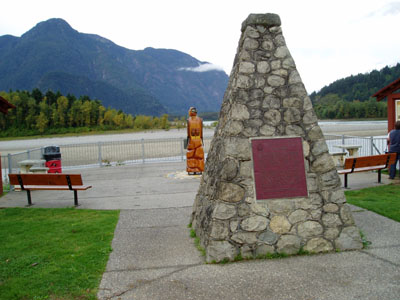Fort Hope National Historic Site of Canada
Hope, British Columbia

General view
© Parks Canada | Parcs Canada, 2008.
Address :
Corner of Wallace and Water Streets, Hope, British Columbia
Recognition Statute:
Historic Sites and Monuments Act (R.S.C., 1985, c. H-4)
Designation Date:
1925-05-15
Dates:
-
1848 to 1860
(Significant)
Event, Person, Organization:
-
Hudson’s Bay Company
(Organization)
Other Name(s):
-
Fort Hope
(Designation Name)
Research Report Number:
2010-SDC-CED-028
DFRP Number:
56493 00
Plaque(s)
Existing plaque: Small park along Fraser River corner of Wallace and Water Streets, Hope, British Columbia
When the boundary settlement of 1846 determined that the mouth of the Columbia would be American territory, that river became impractical as a supply route for the Hudson’s Bay Company. Instead, goods were brought up the Fraser from Fort Langley to the head of navigation, where Fort Hope was built to 1848-49. From here they were sent by pack train to Kamloops and thence to Alexandria for distribution by water to the posts of New Caledonia. This complex system was used until gold discoveries stimulated road construction after 1860.
Description of Historic Place
Fort Hope National Historic Site of Canada is situated in the town of Hope in southern British Columbia. In 1848-49 a Hudson’s Bay post surrounded by a stockade was constructed here facing the Fraser River. There are now no known remaining resources associated with the site of Fort Hope. Located at 211 Wallace Street the designated site occupies 0.6 hectares and currently comprises a small block of commercial buildings and parking lots. The Historical Sites and Monuments Board of Canada cairn commemorating Fort Hope stands a short distance from the site on the bank of the Fraser River, at the corner of Wallace and Walter Street. Official recognition refers to the approximate location of the former fort in the town of Hope, BC.
Heritage Value
Fort Hope was designated a national historic site of Canada in 1925. It is recognized because: the construction of Fort Hope is connected with the economic development and international relations of the country. It was built in response to the 1846 boundary settlement and served as a transfer point for goods brought up the Fraser River from Fort Langley to the pack trains for Kamloops and thence to Alexandria for distribution by water to the posts of New Caledonia. This complex system was used until gold discoveries spawned road construction after 1860; Indigenous Peoples, their territories, and labour were foundational to the fur trade in North America. Posts were often built near existing Indigenous settlements, trading routes and/or meeting places and became important sites of economic, social and cultural exchange.
Constructed as a trading post at Hope by the Hudson's Bay Company, Fort Hope was one of the elements which opened a way into the interior of the country through British territory. The heritage value of Fort Hope National Historic Site of Canada resides in its historical associations with Canada’s economic development and contributing to the building of international relations. When the boundary settlement of 1846 determined that the mouth of the Columbia River would be American territory, the Columbia River became impractical as a supply route for the Hudson's Bay Company. The Hudson’s Bay Company decided instead to bring the goods from Langley up the Fraser River to the head of the navigation, where Fort Hope was built in 1848-49. The fort was the point of transfer from water to land on the “Brigade Trail” between Fort Langley and the posts of the interior. From Fort Hope, the goods were sent by pack train to Kamloops and then onwards to Alexandria for distribution by water to the posts of New Caledonia, a district of the Hudson’s Bay Company in British Columbia. This complex system was used by the Hudson’s Bay Company until gold discoveries spawned road construction in the area after 1860. Currently the site comprises a small block of commercial buildings and parking lots serving local businesses and community interests.
Sources: Historic Sites and Monuments Board of Canada, Minutes, May 1926, October 2010, December 2020.
Character-Defining Elements
Key features contributing to the heritage value of this site include: the site’s location occupying approximately 0.6 hectares on a flat area in the western end of the town of Hope, in southern British-Columbia; the setting overlooking the junction of the Fraser River, a short distance from where the Historic Sites and Monuments Board of Canada plaque is located on a small plot of land owned by Parks Canada; the integrity of any surviving or as yet unidentified archaeological remains relating to the fort, which may be found within the site in their original placement and extent; the viewscape from the site across the Fraser River.